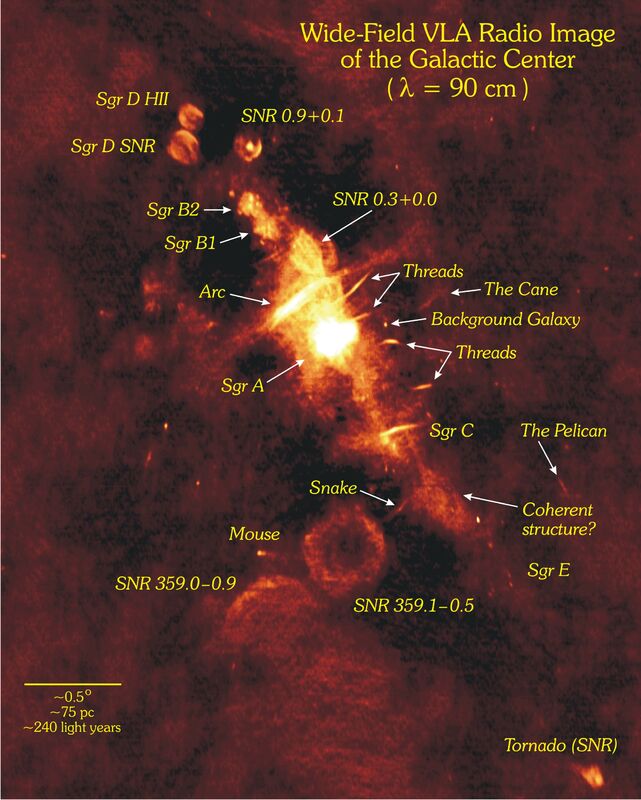Galactic Center Wide Field VLA Radio Image
Description
Forever hidden behind a thick veil of dust and gas, the center of our Milky Way Galaxy cannot be seen in visible light, the kind of light that our eyes see. In order to study the center of our Galaxy, astronomers must turn to other colors of light, like gamma-rays, X-rays, infrared, and radio. This panoramic view of the center of our Milky Way Galaxy is at a radio wavelength (color) of approximately 1 meter. This image is the largest and most sensitive radio image ever made of the Milky Way's center at a uniform and high resolution. The beauty and complexity of this image excites the imagination of experts and non-experts like. The concentration of sources along a diagonal line through the image reveals the disk-like shape of the Milky Way viewed edge-on. This image also serves as a useful tool for astronomers because it displays all of the major components of the Milky Way's center region in a single image. The most prominent source in the image is Sgr A. (Its name derives from the fact that the Milky Way's center is in the direction of the constellation Sagittarius, abbreviation Sgr. Deep within Sgr A is the source Sgr A*, which astronomers have identified as possibly being a black hole with a mass millions of times that of the Sun. Sgr A is clearly not the only source, though. As hot young stars form, they heat the gas around them. Eventually, the gas can become hot enough that it glows, serving as a lamppost to show where stars are forming. There are a number of prominent regions of star formation in the Milky Way's center including Sgr B1 and B2 and part of Sgr D. When hot stars run out of fuel, they collapse, producing massive explosions known as supernovae. The explosive debris becomes a supernova remnant, within which high-speed electrons are spiraling around magnetic fields. A number of such supernova remnants are visible within this image. In addition, this spiraling or synchrotron radiation seems to be responsible for a collection of enigmatic sources known as the Galactic center arc, filaments, and threads. The true nature of these filamentary structures remains a mystery, though it is clear that their emission, orientation, and structure provide important clues to the energetics and large-scale magnetic field structure in the center of the Milky Way. This image has also led to the discovery of many new sources, including a new supernova remnant, numerous pulsar candidates, several new filamentary structures, and a mysterious transient source.
This image was made from archival data which were reprocessed using modern, wide-field imaging software (Cornwell's SDE DRAGON routine). The archival data were kindly provided by A. Pedlar from multi-configuration observations (A, B, C, D) originally taken between March 1986 - May 1987. The resolution is 48" x 48". The peak brightness is 8.5 Jy/beam, and the rms noise level (excluding the bright sources on the Galactic ridge) is 5.9 mJy/beam.
Creator
Legacy Astronomical Images
Rights
NRAO/AUI/NSF does not hold full copyright for this image. Contact the archivist for details.
Type
Legacy Astronomical Image
Object Name
Sgr A
Photo Credit
N.E. Kassim, Naval Research Laboratory
Investigators
N.E. Kassim, T.J.W. Lazio, T.N. Larosa, D.S. Briggs
Telescope
Very Large Array (VLA)
Observation Date
1986-03-10
Type of Observation
continuum
Center of Image
RA 17:43:15.000, Dec: -28:52:0.000 (J2000)
Field of View
2.500000 x 4.000000 degrees
Link to journal article
Notes
Contact the archivist for a high resolution tif of this image.
Series
Galactic Sources Series
Unit
Galactic Center Unit
Citation
Legacy Astronomical Images, “Galactic Center Wide Field VLA Radio Image,” NRAO/AUI Archives, accessed April 25, 2025, https://www.nrao.edu/archives/items/show/33445.

